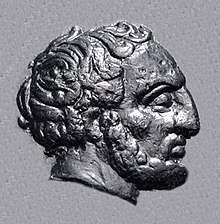Hydarnes
Hydarnes I or Hidarnes I, also known as Hidarnes the Old by contrast with his son Hidarnes the Young (Greek: Ὑδάρνης, from Old Persian Vidarna- possibly New Persian H(a)idar), son of Bagābigna, was a Persian nobleman of the Achaemenid Empire in the late 6th and early 5th centuries BC. He was one of the seven conspirators against the usurper, Gaumâta, who killed him and then proclaimed Darius I as the Persian king. His name appears in the Behistun inscription among the six conspirators who supported the rise of Darius the Great. Hydarnes then served Darius I as a commander and remained influential during his reign.
| Hydarnes | |||||
|---|---|---|---|---|---|
| Satrap of Parthia, Hyrcania, Media, Matiene and Sophene | |||||
 Darius I, and five other conspirators, including Hydarnes, invoking the sun to become King. | |||||
| Reign | 521 - 480 BC | ||||
| Issue | Hydarnes II, Stateira, Terituchmes, Sisamnes | ||||
| |||||
| House | Achaemenid | ||||
| Dynasty | Achaemenid | ||||
Etymology
The etymology of Vidarna is debatable. It is possible that it is from the root vida meaning knowledge with Vidarna signifying "the one who knows". Others believe the compound vi-drna suggests "strike" as in "one who strikes". The latter etymology raises an interesting prospect, for in Modern Persian and Urdu there is a possible surviving variant of the name in H(a)idar (حیدر) long thought to be of Arabic origin due to its literation but which means lion (the striking animal). If this is so, Vidarna could be rendered lion-like. for the lion also had obvious associations with Mithra, a major god of the Achaemenid religion.
Life
In 522 BC, a Magian named Gaumâta seized power in the Achaemenid empire, claiming to be Smerdis, the brother of the legitimate king Cambyses. Hydarnes was one of the seven conspirators along with Otanes, Ardumanish, Gobryas, Intaphrenes, Megabyzos and Darius against the usurper Gaumâta. After they killed Gaumâta in September 522 BC, they proclaimed Darius the new Great King of Persia.[1]
After the successful transfer of power, Hydarnes served Darius I as a commander against the rebellious Medes under Phraortes. In 521 BC, the Persians defeated the Medes in a battle near Maruš (Mehriz, thirty kilometres south of modern Yazd).[2]
Hydarnes remained an influential man during the reign of Darius. From tablets found at Persepolis, it is known that he was satrap of Media in 499 BC.[3] The influence of Hydarnes also secured the appointment of his sons as satraps. Herodotus states that Hydarnes’ son Sisamnes was the satrap of Aria and that the younger Hydarnes was "in command of the whole Asian seaboard".[4] During the Second Persian invasion of Greece in 480 BC, the younger Hydarnes was given command of the "Immortals";[5] while Sisamnes was given command of a levy of Arian troops.[6]
Hidarnes established the "Yervandakan" feast in the name of the Orontid Dynasty, which sounds in Armenian as "Yervanduni". The feast was dedicated to the Orontid Dynasty, Van city or, as it was called in those days, Yervandakan, Lake Van and Hayots Canion Gorge.[7]
Descendance

Tissaphernes, 4th century BC satrap of Lydia, was the great-grandson of Hydarnes.
References
- Pierre Briant: From Cyrus to Alexander. A History of the Persian Empire. Translated by Peter T Daniels Eisenbrauns, 2002, ISBN 1-57506-031-0
- Herodotus, Herodotus, with an English translation by A. D. Godley. Cambridge. Harvard University Press. 1920.
Notes
- Herodotus: Histories III, 70
- Behistun Inscription, Column 2, §25.
- "Livius.org Articles on ancient history". Hydarnes (1). 1 January 2015. Retrieved 8 February 2015.
- Herodotus, Histories VI,133
- Herodotus: Histories. VII, 83
- Herodotus: Histories. VII, 66
- Khachatryan, Hayk (2006). 141 Kings of the Armenians. Erevan: Amaras. ISBN 978-99930-1-192-7